|
-
7th March 11, 12:03 AM
#1
Favorite Scottish Engineering Feats?
What is your favorite engineering feat or accomplishment in Scotland?
You can throw in scientific achievements and inventions too.
Bridges, water works, structures, theorems, ancient toilets; what ever floats your boat.
I tried to ask my inner curmudgeon before posting, but he sprayed me with the garden hose…
Yes, I have squirrels in my brain…
-
-
7th March 11, 02:15 AM
#2
James Watt invented the separate condenser which made the steam engine practical for industry. Plus we have the same surname.
"Blood is the price of victory"
- Karl von Clausewitz
-
-
7th March 11, 03:04 AM
#3
Prior to the advent of railroads goods and supplies were moved using a system of canals.
But the water in canals can't flow uphill or over terrain, so a system of locks were used to raise and lower barges.
Here is a pic of a typical canal.
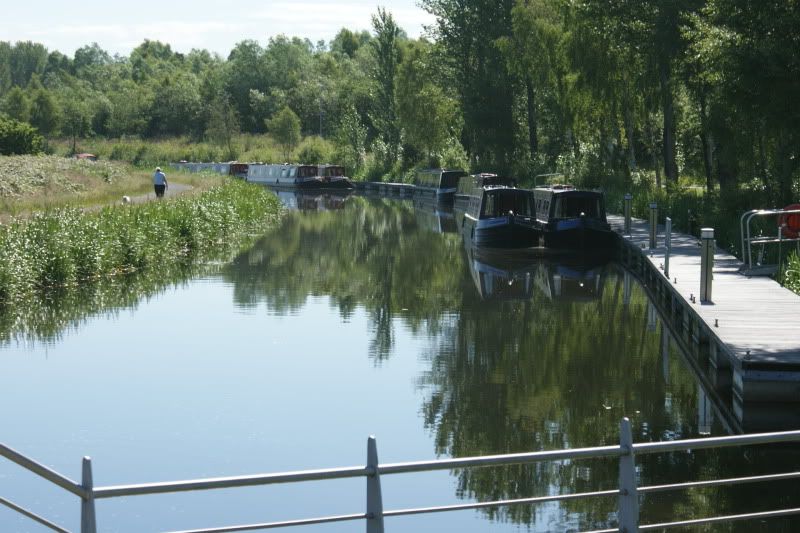
Note the canal barges along the bank.
In the area of Scotland known as Falkirk, South of Stirling, two canals, the Forth and Clyde, ran to within a quarter of a mile from each other. There was a problem though. There was a line of hills and a difference in elevation of 79 feet seperating them. A system of 11 locks were built in the 1880's to connect these two canals but a single barge took an entire 24 hours to traverse the 1/4 mile.
By the 1930's the canals were silted up and had fallen into dis-use.
In 2004 in a effort to reopen and revitalize the Scottish canals a unique and ambitious progect was completed and officially opened by Queen Elizabeth II as part of her Golden Jubilee Celebration.
I give you my favorite Scottish Engineering project. - The Falkirk Wheel.
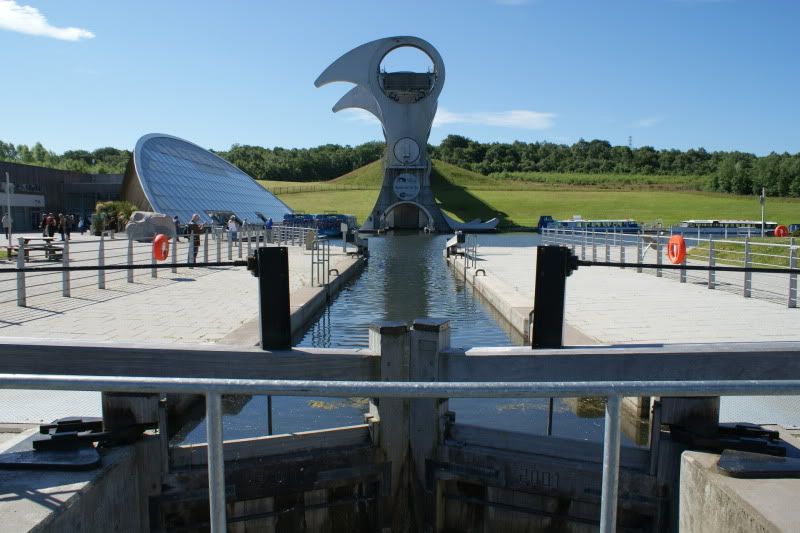
Today, The Falkirk Wheel carries tourists on a one hour ride from the lower Forth Canal up to the higher Clyde Canal and back.
Here you can see the tourist canal boats loading for a trip.
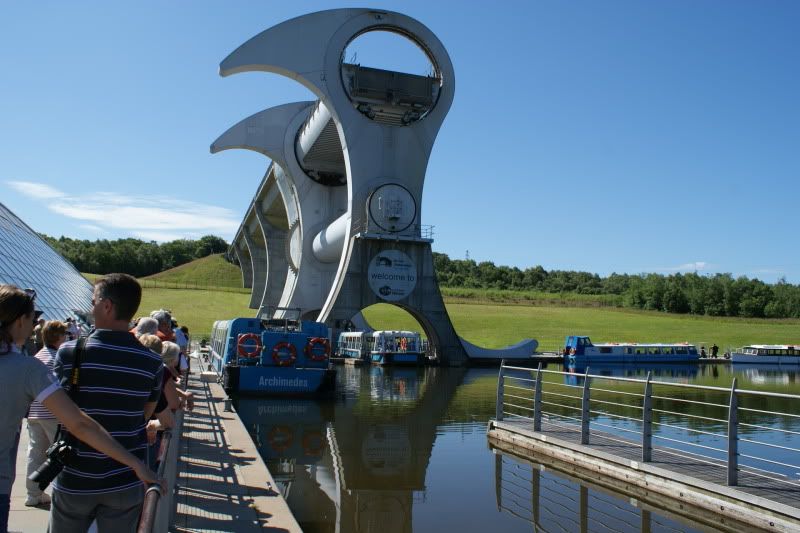
Behind the wheel you can see the aquaduct that comes from the higher canal passing through a tunnel that goes through the hill you can see.
Here is a shot of the Wheel from the other side, about half way up the hill.
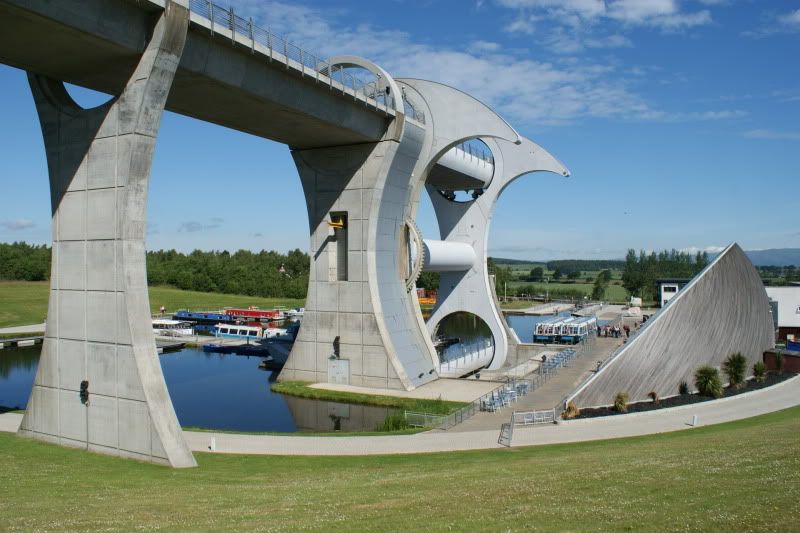
You can just see two barges nestled into the lower gondola. There are also two barges in the upper gondola.
And then the magic happens.
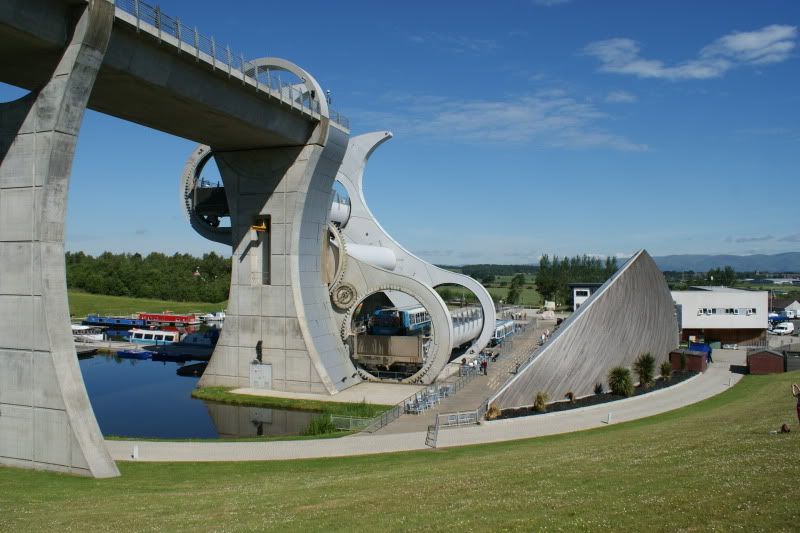
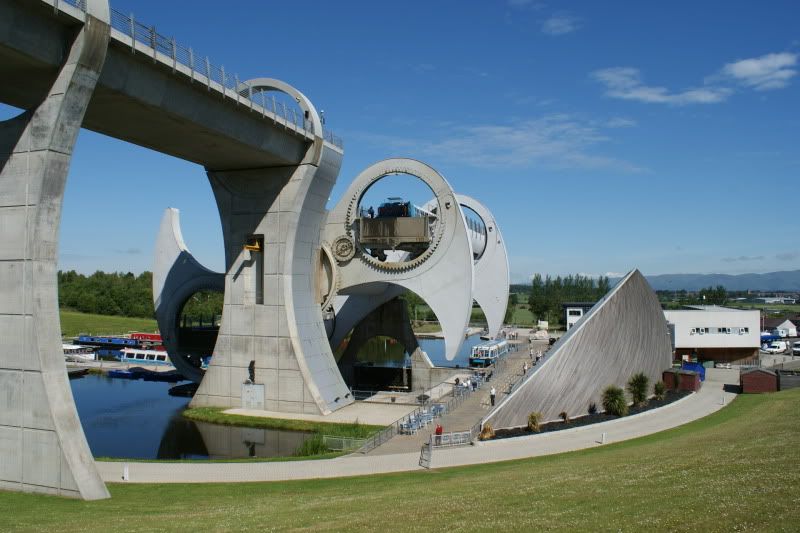

The entire Wheel rotates. Each rotation of the Wheel can take four barges in each arm. The weight of the barges and water balance the two arms so perfectly that the entire Wheel can be operated with an electric motor using no more power than a normal household refrigerator uses in one day.
This thing is huge. Here is a close up.
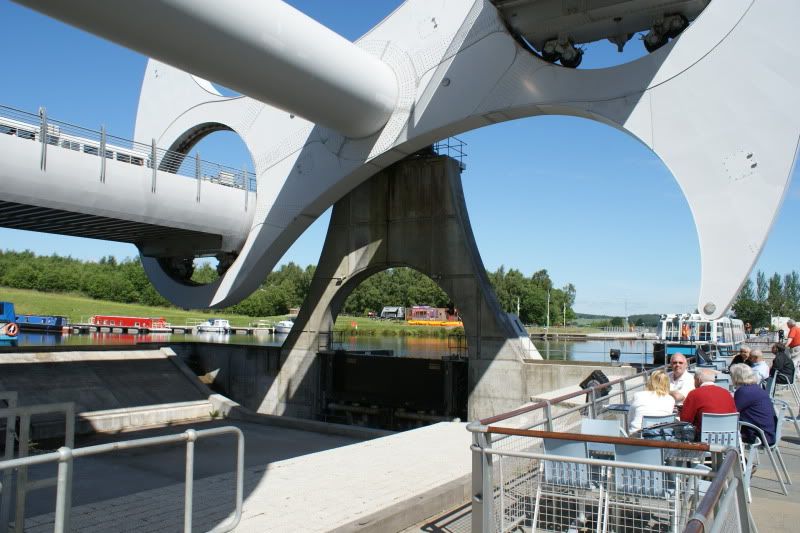
The Falkirk Wheel is the world's only rotating boat lift.
I hope you enjoyed this tour of my favorite Scottish Engineering Project.
-
-
7th March 11, 05:06 AM
#4
Thank you, Steve. While I have seen pictures of the wheel before, this is the best presentation of it I have yet come across.
Regards,
Mike
The fear of the Lord is a fountain of life.
[Proverbs 14:27]
-
-
7th March 11, 06:40 AM
#5
Watt did a whole lot more than the condenser...he devoloped huge pumping engines that carried water out from under london to keep it from floating off...he did some work with valving and reversing gear for steam engines too as I recall..
I love the falkirk wheel...it almost seems like a grad student prank...hey, thimk they will buy off on this?
-
-
7th March 11, 07:37 AM
#6
Does the name Alexander Graham Bell ring any...well, bells? Although not technically the first to do it he was the first to patent and popularize the telephone, invented electronic hearing aids, and several other electircal devices during his lifetime. Born in Scotland, raised in Canada and eventually set up shop in Boston working with the deaf (his father was one of the inventors of sign language so it came naturally in his family).
I would say those are some pretty significant accomplishements.
-
-
7th March 11, 10:03 AM
#7
 Originally Posted by ForresterModern

Does the name Alexander Graham Bell ring any...well, bells?
Born in Scotland, raised in Canada and eventually set up shop in Boston working with the deaf (his father was one of the inventors of sign language so it came naturally in his family).
I would say those are some pretty significant accomplishements.
And some of my favourite bits of trivia:
First:
"Dad" (Alexander Melville Bell) is the prototype for Prof. Henry Higgins in the musical My Fair Lady - more originally the play Pygmalion by George Bernard Shaw, Shaw paid tribute to Bell Sr. by referring in the play, to his textbook "Bell's Visible Speech" Bell the elder could actually achieve Higgins's stage feat of identifying someone's land of origin by their speech patterns and inflections.
Second:
Q. What was Alexander Graham Bell's name? (Sounds obvious, but it isn't.)
A. Alexander Bell. He said that there were too many "Alexanders" in the family, so he would go by Graham. He always signed his name "A. Graham Bell" and the only person who normally used his actual name was his father when the lad was in trouble, as in "A-a-a-alex!"
Despite his many accomplishments (Bell was also part of the inventing team which launched the "Silver Dart" at Baddeck, Nova Scotia, Canada, the first powered flight in the British Empire) Bell always gave his profession as "teacher of the deaf." Actually, he married one of his deaf students, a Miss Mabel Hubbard - a lifelong love affair, and it was Bell's Father-in-Law who bankrolled Bell's many researches.
Rev'd Father Bill White: Mostly retired Parish Priest & former Elementary Headmaster. Lover of God, dogs, most people, joy, tradition, humour & clarity. Legion Padre, theologian, teacher, philosopher, linguist, encourager of hearts & souls & a firm believer in dignity, decency, & duty. A proud Canadian Sinclair with solid Welsh and other heritage.
-
-
7th March 11, 10:44 AM
#8
David Dunbar Buick
Buick unleashed the potential of the internal combustion engine with his invention of over-head inlet and exhaust valves, something still used by all automobile manufacturers today, with the exception of those cars using the German-designed Wankle rotary engine.
-
-
7th March 11, 10:55 AM
#9
I am sorry, I did not make my question clear enough.
I said "in Scotland."
That being said, I'm just thankful people are posting, so carry on.
I tried to ask my inner curmudgeon before posting, but he sprayed me with the garden hose…
Yes, I have squirrels in my brain…
-
-
7th March 11, 11:10 AM
#10
I'm with the Wizard. I vote for the falkirk Wheel as my all time favorite. No one else has anything like it.
Victoria
Just because you are paranoid doesn't mean they aren't out to get you.
-
Similar Threads
-
By hospitaller in forum Miscellaneous Forum
Replies: 37
Last Post: 1st August 09, 11:45 AM
-
By Rogerson785 in forum Show us your pics
Replies: 4
Last Post: 19th April 09, 03:56 AM
-
By MacMillan of Rathdown in forum Miscellaneous Forum
Replies: 76
Last Post: 24th February 08, 03:06 AM
 Posting Permissions
Posting Permissions
- You may not post new threads
- You may not post replies
- You may not post attachments
- You may not edit your posts
-
Forum Rules
|
|
Bookmarks